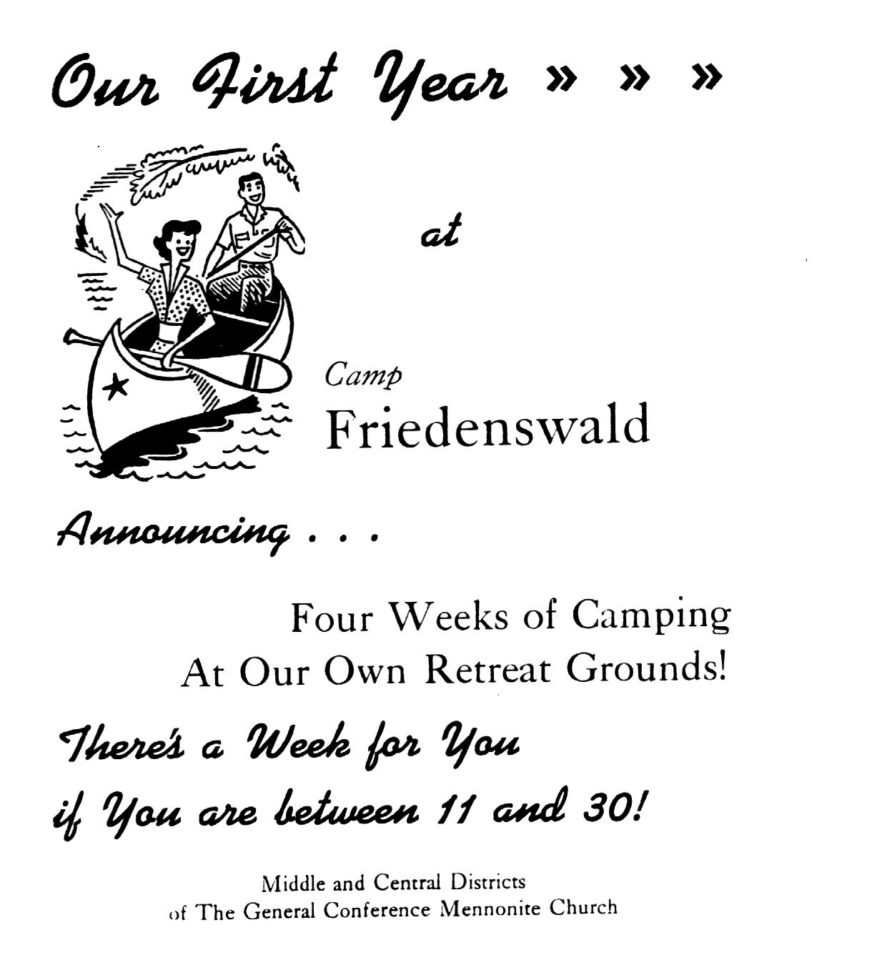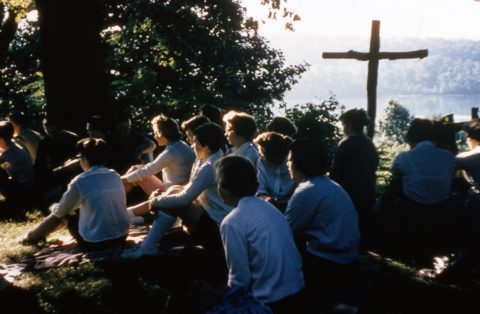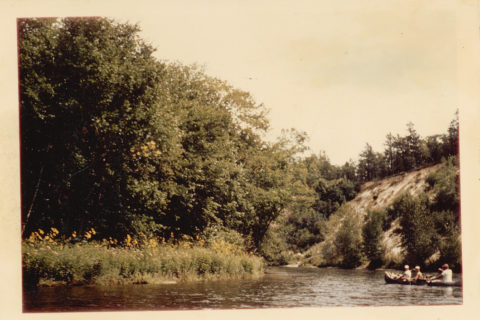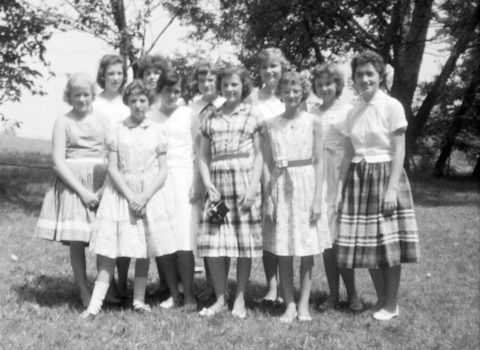
The following reflection comes from the writings of Anna Juhnke, former Bethel College (KS) English teacher, and leader in the Mennonite church. Anna died in 2005. They are part of a larger body of work “Speaking for Herself: The Autobiographical Writings of Anna K. Juhnke”, edited by Joanne Juhnke and James C. Juhnke. The entirety of the writings can be found here. The photos in this blog are from the general era Anna writes about and are part of Camp Friedenswald’s collection of historical photos. This post is shared in celebration of Camp’s 75th Anniversary.
Camp Friedenswald was the highlight of my year, from its opening in 1950 or 51, when Emil and Bobby Kilmer were the first registrants of the raw, new camp, right through high school. I remember that first year not having a dining hall. Cooking was done in one of the cabins, and we ate on benches made from boards over cinder blocks under a tarp, while rain water rushed under our feet. There was no beach there on Shavehead Lake, and you sank in the muck wading out to the deep water to swim to the diving raft. For a couple of years we had bucket brigades to drop sand into the water for better footing. But even that was fun. It was so wonderful to learn to row a boat on a real lake and to live on wooded hills. On Inspiration Point, you could look past the rugged cross down across the lake.

I liked living in a cabin with kids like me. How we enjoyed Mary Jo Diller’s birthday cake one year, even eating the stale popcorn Mrs. Diller had stuffed around it for mailing. I adored the fine young cabin counselors, lifeguards, and craft instructors, like Ruth Gilliom, John Bohn, and John Bauman. I enjoyed all the rituals, even cabin cleaning and dish duty after lunch. There were campfires in Mosquito Hollow, Morning Watch alone in a secluded spot, chapel on rough benches under the trees, a cookout across the lake, stunt night, talent night, and singing silly songs at the table: “What did Ida-hoe?. . .What did Dela-ware?”

Crafts both at camp and at the Wadsworth Rec Center tended to feature Lustre Lace. I must have braided dozens of lanyards and bracelets. I still have the aluminum tray on which I etched “Camp Friedenswald” and a flower. I started making notebooks full of camp songs, which I would later teach Sara. Our worship and our religion classes, led by people like Dave Habegger and Robert Kreider, were always so much better than we had in Wadsworth. I learned about the persecuted Anabaptists, and always dedicated my life to Christ when we set our candles out in little paper boats on the lake the last night of camp. Dad did more than his share of those long Sunday trips to Michigan that were so exciting to me. And when we didn’t want to lose our perfect attendance record for Sunday-School, he obligingly stopped at some roadside park and taught our Sunday-School lesson at a picnic table. One of my favorite activities from age 10 or 11 on was writing to penpals. Some were girls I met at camp, like Sue McKibben, Mary Alice Baumgartner, and Roberta Leisy

When I felt so marginal socially at school, it was nice to know I would fit in perfectly at Camp Friedenswald. In high school camp I appreciated the year when our small group could choose our own topics. My group chose Betty van der Smissen on recreation leadership, a session on singing unfamiliar hymns in four parts, and nature hikes with H.W. Berky, who taught us about dwarf sumac, poison sumac, and sassafras. One year Bob McCrory (a poor and acne-scarred Chicago kid whom I sort of liked) and I led the rebellion against Bill Keeney as camp director. We actually wanted him to step down and let Dave Habegger be the director! I later wrote him an apology and got a kind reply. Many of my camp friends and I were planning to go to Bluffton College. We were encouraged by Bluffton Night at camp, when the counselors would sing “Hail to thee, dear Bluffton College” so beautifully. When I started to earn money at the library, my first contributions beyond the church offering were to Friedenswald.
Speaking for Herself
The Autobiographical Writings of Anna K. Juhnke
Edited by Joanne Juhnke and James C. Juhnke
Printed by ADR Wichita, Kansas